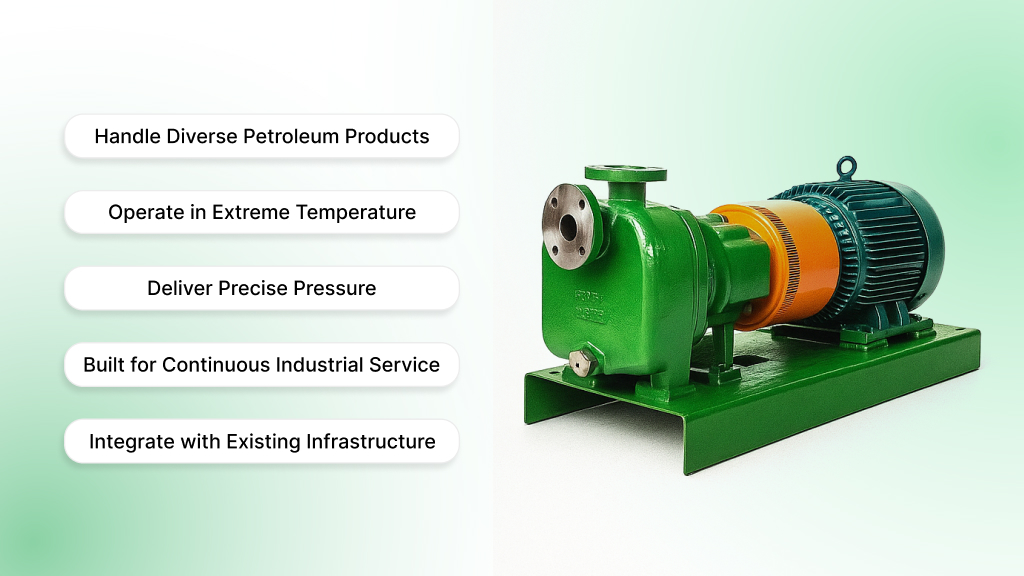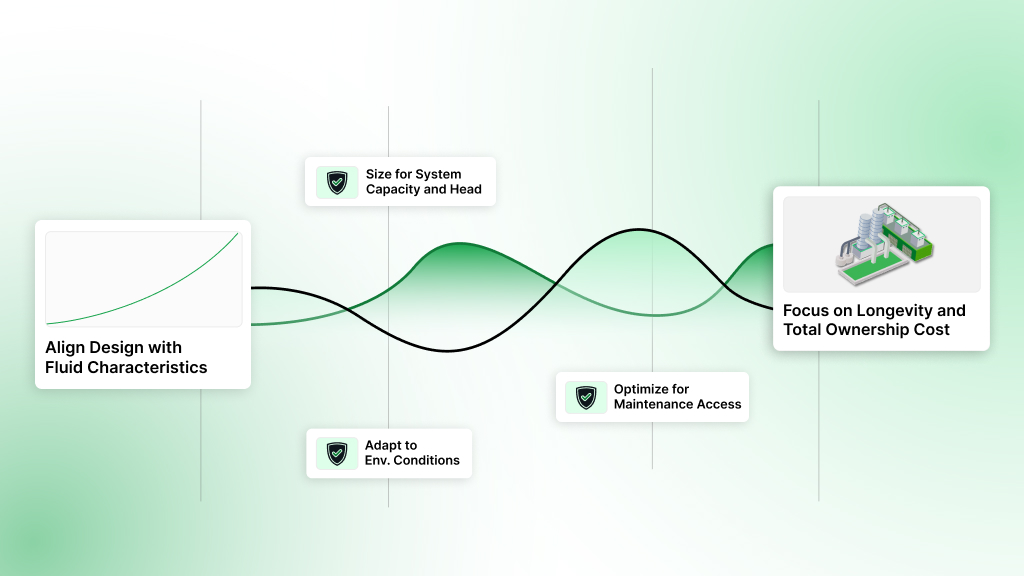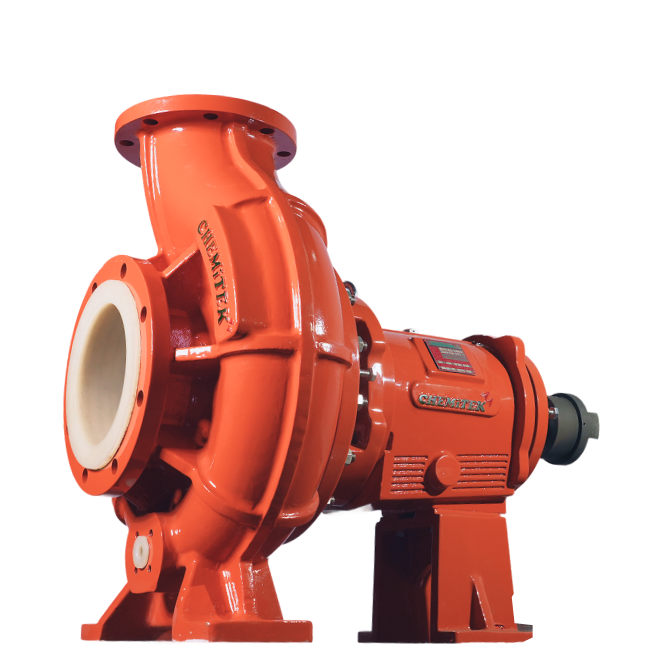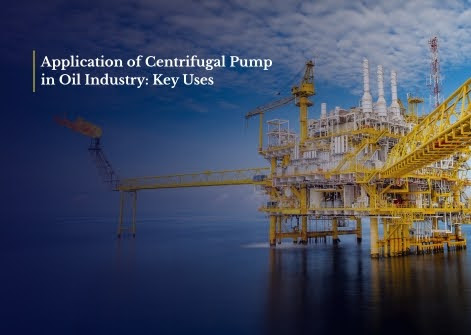Efficient fluid movement in the oil industry, handling everything from light fuels to abrasive crude, depends largely on centrifugal pumps, which make up over 20% of industrial pump usage worldwide.
This reliance is reflected in the global market, valued at USD 39.7 billion in 2023 and expected to reach USD 51.5 billion by 2028, showing increased demand for reliable pumps in challenging environments.
The application of centrifugal pump in oil industry ensures continuous operation across upstream extraction, midstream transport, and downstream refining. Their durable design helps reduce equipment wear, minimize downtime, and maintain safety standards throughout the process.
This blog examines the application of centrifugal pumps at each stage of the oil value chain and why they are vital for smooth and efficient operations.
Key Takeaways
- Centrifugal pumps play a critical role in the oil industry by using a rotating impeller to move fluids, converting rotational energy into kinetic energy, and then into pressure.
- The application of centrifugal pump in oil industry spans upstream, midstream, and downstream phases, with each stage requiring specific performance capabilities.
- Depending on operational needs, these applications may use single-stage, multistage, submersible, or vertical/horizontal pump designs.
- Pump selection is guided by fluid type, operating temperature, required pressure, and environmental conditions.
- When correctly matched to the process, centrifugal pumps improve uptime, lower operational costs, and maintain compliance in demanding oil sector environments.
Role of Centrifugal Pumps in the Oil Industry

A centrifugal pump moves liquid using an impeller enclosed in a casing. As the impeller spins, it accelerates fluid outward, converting velocity into pressure for transport.
Unlike positive displacement pumps, which deliver fixed volumes regardless of system resistance, centrifugal pumps are ideal for continuous, high-volume flow, serving as the foundation of oil industry fluid handling. Their simple design, with fewer moving parts, also results in lower maintenance needs in remote or hazardous environments.
Key strengths of Using Centrifugal Pumps for Oil Industries:
- Simple and compact design that ensures easy operation, space efficiency, and low initial investment cost.
- Ability to handle a wide viscosity range from light refined fuels to heavy crude oil while providing smooth, pulsation-free, continuous flow.
- Low maintenance requirements due to fewer moving parts, which reduces downtime and operating costs.
- Durable construction that minimizes wear and tear even when pumping corrosive and abrasive liquids, ensuring long-lasting performance.
- Reliable performance in harsh environments including extreme temperatures and chemically hazardous locations.
Types of Centrifugal Pumps Used in the Oil Industry
In the oil industry, fluid handling requirements vary significantly depending on processing stage, location, and pressure demands. The application of centrifugal pump in oil industry involves multiple pump designs tailored to meet these diverse conditions.
Each design offers specific features suited for different tasks, ensuring smooth operations across the value chain.
Below is an overview of the main types of centrifugal pumps used in the oil sector, highlighting their design features (metallic or non-metallic) and typical applications:
After reviewing the types, we will examine the application of centrifugal pumps across key stages in the oil industry.
Application of Centrifugal Pump in Oil Industry Across Processes

The application of centrifugal pump in oil industry spans every phase, from wellhead operations to final product delivery. To grasp the full scope of the application of centrifugal pump in oil industry, it’s important to examine their use stage by stage, beginning with upstream operations.
Upstream Applications
Upstream refers to exploration and production activities, including locating oil reserves, drilling wells, and bringing crude oil or gas to the surface and the operations rely heavily on pumps designed to handle high pressures and abrasive fluids, ensuring efficient extraction and processing at the source.
Applications of centrifugal pump in upstream operations:
- Water Injection for Enhanced Oil Recovery (EOR): High-pressure multistage pumps inject treated water into reservoirs to maintain pressure and push crude oil toward production wells. This process can extend the life of mature fields and increase recovery rates by up to 40%.
- Dewatering: Reliable pumping systems remove unwanted water from drilling sites, preventing equipment corrosion, ensuring stable drilling conditions, and avoiding costly delays in exploration activities.
Midstream Applications
During midstream operations, pumps play a critical role in safely and efficiently transporting crude and refined products. Within the application of centrifugal pump in oil industry, this stage demands pumps that provide consistent flow and pressure to support pipelines and storage facilities.
Applications of centrifugal pump midstream operations:
- Pipeline Transport: Multistage centrifugal pumps maintain consistent flow across hundreds of kilometers of pipeline, reducing the need for additional pumping stations and ensuring delivery timelines are met.
- Storage Terminals: Pumps handle the controlled loading and unloading of oil and petroleum products, minimizing spillage risks and meeting strict environmental and safety regulations.
Downstream Applications
Downstream focuses on refining crude oil into fuels, lubricants, and petrochemicals and distributing them to end users, where centrifugal pumps support energy-intensive and precision-driven processes.
Applications of centrifugal pump downstream operations:
- Distillation Processes: Pumps feed crude oil into distillation towers, ensuring a steady, controlled flow for optimal separation of hydrocarbon fractions.
- Cooling Systems: Circulate cooling water through heat exchangers to regulate temperatures in refining equipment, protecting against overheating and maintaining product quality.
- Waste Management: Specialized pumps handle oily wastewater, slurries, and chemical byproducts for safe treatment or disposal, ensuring environmental compliance and reducing the risk of contamination incidents.
To fully understand their impact, next explore the practical application of centrifugal pumps in the oil industry.
Practical Application of Centrifugal Pumps in Oil Industry

Centrifugal pumps are a cornerstone of oil transfer operations because they move fluids through kinetic energy, making them well-suited for continuous, high-volume flow systems. Their efficiency, reliability, and versatility allow them to meet the varied demands of upstream, midstream, and downstream oil industry processes.
1) Handle Diverse Petroleum Products
- Transports petroleum from light refined fuels with viscosities under 5 cSt to heavy crude oils exceeding 500 cSt.
- Safely manages toxic, flammable, and corrosive products such as benzene, toluene, and sour crude.
- Offers multiple hydraulic configurations, including single-stage and multistage designs, to match fluid properties.
- Uses open impeller designs with 6–8 mm clearance to prevent clogging when handling crude oil containing solids.
- Compatible with petroleum streams containing up to 5% sand or abrasive particles without excessive wear.
2) Operate in Extreme Temperature Conditions
- Delivers reliable performance from -50°C for Arctic offshore platforms to +260°C for desert refinery applications.
- Resists thermal shock from rapid temperature swings of up to 100°C within minutes.
- Prevents cracking and fatigue through the use of high-grade stainless steel and alloy materials.
- Maintains consistent performance in ambient conditions from sub-zero cold storage to high-heat processing units.
- Handles heated crude oil transfers at 200°C without degradation of pump seals or bearings.
3) Deliver Precise Pressure and Flow Control
- Supports flow rates up to 1,590 m³/h (7,000 GPM) for large-scale loading and transfer operations.
- Generates head pressures up to 223 m (730 ft) for long-distance pipeline transport over varied terrain.
- Maintains flow stability within ±2% during fluctuating inlet pressures or viscosity changes.
- Accommodates both short-duration high-flow tank loading and continuous 24-hour pipeline operations.
- Ensures uninterrupted supply for offshore platforms requiring precise output control for process safety.
4) Built for Continuous Industrial Service
- Complies with ANSI/ASME B73.1 standards to meet petrochemical plant requirements for 24/7 service.
- Fitted with Class 150 FF flanges rated for pressures up to 285 psi at 38°C.
- Engineered for continuous operation in high-salinity offshore environments and refinery process units.
- Constructed with wear-resistant impellers and hardened shafts to extend service intervals.
- Uses corrosion-resistant alloys such as duplex stainless steel to handle aggressive petroleum additives.
5) Integrate with Existing Oil Infrastructure
- Matches standard piping diameters from 2 inches to 12 inches for seamless integration.
- Compact footprint fits within platform skid spaces as small as 1.5 m².
- Compatible with electric motors from 15 kW to 400 kW and standard VFD control systems.
- Suitable for both retrofit projects replacing outdated pumps and new plant installations.
- Designed with ANSI/ISO standard connection interfaces to minimize installation time and reduce project costs.
Now, we turn to how selecting the right centrifugal pump impacts performance in the oil industry.
Selecting the Right Centrifugal Pump for Oil Industry

The performance, safety, and efficiency of an oil transfer system often depend on choosing the correct pump.
Selecting a centrifugal pump is not simply about matching catalog data. The decision should be based on how the pump will perform under actual process conditions.
1. Align Design with Fluid Characteristics
Select hydraulic designs and wetted materials according to viscosity, abrasiveness, corrosiveness, and temperature range of the oil.
- For high-temperature oils (above 150°C), use metallurgy such as stainless steel or carbon steel with seals rated for at least 260°C.
- Choose open or semi-open impellers for crude or produced water mixtures containing solids up to 3 mm in diameter to minimize clogging.
- For corrosive crude, specify materials such as duplex stainless steel or high-nickel alloys.
2. Size for System Capacity and Head
Match pump size, impeller diameter, and stage count to the system’s duty point (m³/h and head in meters).
- For long-distance transfer pipelines exceeding 3 km, use multistage designs to sustain discharge pressures above 200 meters without overloading the motor.
- Confirm that the pump performance curve aligns with expected operating conditions at 80–110% of the best efficiency point (BEP) to reduce energy losses.
- Allow a minimum NPSH (Net Positive Suction Head) margin of 1 meter above system requirements to avoid cavitation.
3. Adapt to Environmental Conditions
Offshore or coastal installations should use corrosion-resistant materials such as duplex stainless steel, super duplex, or bronze for wetted parts.
- In sandy or dusty regions, use bearing housings with labyrinth seals and IP56 or higher motor protection ratings.
- For hazardous (classified) areas, ensure the pump is certified to API 610 and ANSI-compliant standards, equipped with explosion-proof motors rated for the zone classification.
4. Optimize for Maintenance Access
Select pump configurations that allow mechanical seal, bearing, and impeller inspection without removing the entire pump from the piping.
- Use bearing housings with visual or electronic lubrication inspection systems.
- Where possible, standardize pump types and sizes across the facility to reduce spare part inventory and training complexity.
5. Focus on Longevity and Total Ownership Cost
Consider life-cycle costs, including energy efficiency, wear part replacement intervals, and downtime risks.
- Pumps sized correctly for their duty tend to operate with vibration levels under 4.5 mm/s RMS, extending bearing and seal life.
- Choose designs with proven field performance in similar oil transfer environments to minimize unplanned outages.
Is inefficient pump application affecting your oil industry operations? Discover how Chemitek optimizes centrifugal pump use with expert guidance, tailored solutions, and industry best practices. Find out how today.
Chemitek: Centrifugal Pump Applications in the Oil Sector

At Chemitek Process Equipment Pvt. Ltd., we deliver centrifugal pumping systems built to meet the operational demands of oil sector activities, covering upstream extraction, midstream transport, and downstream refining. Our pumps are engineered for dependable performance, safe handling of petroleum products, and optimal efficiency in continuous service.
Our centrifugal pump solutions handle light fuels to heavy crude with solids, providing precise flow and pressure control through corrosion-resistant, wear-tolerant designs that perform reliably in extreme temperatures for offshore, refinery, and pipeline operations.
We manage every stage from pump selection and system design to installation and start-up, ensuring reduced downtime, extended equipment life, and smooth integration into existing facilities.
Contact us today to discuss the best centrifugal pump setup for your oil sector operations.
FAQs
1. Where are centrifugal pumps used in the oil sector?
They are widely applied for crude oil transfer, product loading at terminals, pipeline boosting, seawater injection in oil fields, and fluid circulation in refining units.
2. Can these pumps handle high-viscosity crude oil?
Yes. With specially designed hydraulics, abrasion-resistant materials, and impellers suited for thicker fluids, they can efficiently move heavy crude without performance loss.
3. How do they operate in harsh temperature conditions?
Pumps constructed with high-alloy metals and temperature-resistant sealing systems can work effectively from -50°C in polar drilling zones to +260°C in heated oil service.
4. Why use open impellers for crude with solid content?
Open impeller designs reduce blockage risk, allowing uninterrupted pumping when handling crude oil with sand, scale, or other particulates.
5. Do centrifugal pumps follow industry compliance standards?
Yes. Pumps built to API 610 specifications meet global oil industry requirements for safety, reliability, and operational efficiency in both offshore and onshore environments.

Latest posts

Application of Centrifugal Pump in Oil Industry: Key Uses
Ready to Upgrade Your Process Operations?